The Context of a Work of Art Relates to Its Web of Connections to the Larger World of Human Culture
How art and culture can assist united states rethink time
(Prototype credit:
Getty Images
)
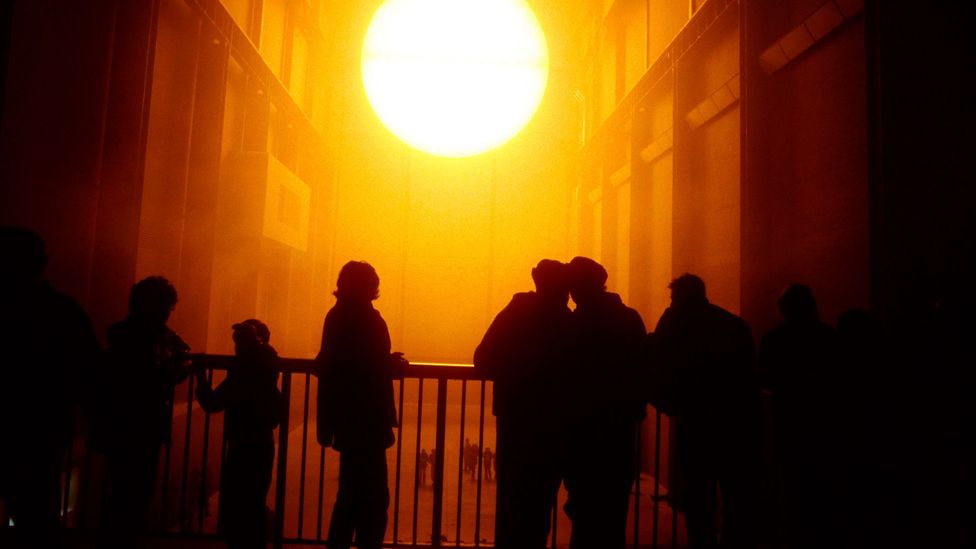
What do photographs of ancient organisms, blocks of ice in the center of London and the blockbuster Black Panther have to do with the future of humanity? Ella Saltmarshe and Beatrice Pembroke explicate.
DEEP Culture
This article is part of a BBC Time to come series about the long view of humanity, which aims to stand up back from the daily news cycle and widen the lens of our current place in time. Modernistic club is suffering from "temporal burnout", the sociologist Elise Boulding one time said. "If one is mentally out of jiff all the fourth dimension from dealing with the present, there is no energy left for imagining the time to come," she wrote.
That's why the Deep Civilization season is exploring what actually matters in the broader arc of human history and what it means for us and our descendants.
There is a line in Hamlet where the prince of Denmark declares, "The time is out of articulation." Shakespeare might take written these words yesterday, not more than 400 years agone, for we live in a world where our perception of fourth dimension is confused. Humanity should exist acting to preserve its long-term future. Instead, brusk-term mindsets and structures dominate. We focus on the present twenty-four hours while neglecting problems that volition endure for centuries – from climate change to ecological collapse.
For most of human history nosotros oasis't needed to call up long-term. It wasn't very useful when we were fugitive attacks from sabre-toothed tigers, desperately foraging for breakfast on the wood floor and surviving extreme weather conditions. Equally futurist Jamais Casio puts it, "In a globe of constant, imminent existential threats, the ability to recognise subtle, long-term processes and multi-generational changes wasn't a particularly important adaptive advantage." Yet today, the nature of adventure has changed. We no longer live in a world of articulate, local cause and effect, and the greatest threats to civilization are happening on the timescale of decades or centuries.
To avert these dangers, we can't wait for our Neolithic mental functions to play evolutionary catch-upwardly, then we demand to supplement them. While our minds might be non exist wired to deal with long-term threats and priorities in the abstruse, they are wired for two things that nosotros can control: story and emotion. Our predisposition towards story, and the deeply emotional nature of our controlling, makes art and civilization foundational to ensuring our future as a species.
You might also similar:
- The perils of short-termism
- The flaw at the heart of republic
- How and why did faith evolve?
That'due south why we accept established an initiative called the Long Time Project, which champions art and culture every bit a road to helping people think and act more long-term. This is about everything from the YouTube videos we watch, to the adverts we curlicue by, to the box-sets we binge, to the art exhibitions we attend, to the theatre we see, to the wearing apparel we wearable and the furniture we use. All these art forms and creative works are shaped past small "c" culture: the commonage values, norms and narratives that underpin and drive our societies. This civilization shapes our collective direction of travel, from the kinds of laws we make, to the applied science we develop, to the way we distribute wealth.
So, how exactly can fine art and civilisation in this broadest sense aggrandize our perception of fourth dimension and the futurity?
Art can stretch our time frames, helping us develop what geologist Marcia Bjornerud calls "timefulness": the ability to locate ourselves inside eras and aeons, rather than weeks and months.
There is a growing body of deep time work that locates united states in the epic geological history of the Universe, evoking awe and wonder. Photographer Rachel Sussman's book The Oldest Living Things in the World contains photographs of organisms more than 2,000 years quondam, like the Pando, a quaking aspen tree that has formed a wood-sized colony by cloning itself continuously for the past 80,000 years.

In her photographs, Rachel Sussman captured organisms more than 2 millennia old (Credit: Rachel Sussman)
As Sussman said in an interview with the Marina Abramovic Institute: "My utilise of deep time is about creating perspective and differentiating between the shallowness of human timescales and the depth of natural, geologic, and cosmic timescales. Information technology's really meant as a way of shifting our perspective… Somewhere along the way I came to the idea that every problem – personal, societal, anything – tin can benefit from long-term thinking. It's a simple idea, just information technology asks yous to wearisome downwardly and consider long-term consequences before acting."
Sussman is not alone in her fascination with deep fourth dimension. Artist-technologist Honor Harger has created a soundscape of the history of the Universe that enables you lot to hear the "oldest song you'll ever hear": the sounds of the cosmic rays left over from the Big Blindside. In 2014, the National Academy of Sciences in Washington DC hosted an exhibition called Imagining Deep Time. And then there is the Deep Time walk, an app produced by a scientist, a playwright and a sound designer that enables people to walk 4.6km through 4.6 billion years of history.
Other artists are stretching our time frames forward, directly engaging with the far future. The Long Now Foundation is building a clock designed to run for ten millennia inside a mount in Texas (read more about the Clock of the Long Now ). And the Longplayer project is a self-extending composition with Tibetan bowls designed by Jem Finer which started on ane Jan 2000 and will go on without repetition until 2999.
Meanwhile, in 2014, artist Katie Paterson created Time to come Library, a woods planted in Norway which will supply newspaper for a special anthology of books to be printed in 100 years' time; Margaret Atwood was the first writer to paw over a manuscript that won't exist read for a century.
All of these works stretch our perspectives, expand our time frames and assist us relocate our beingness in much more epic territory.
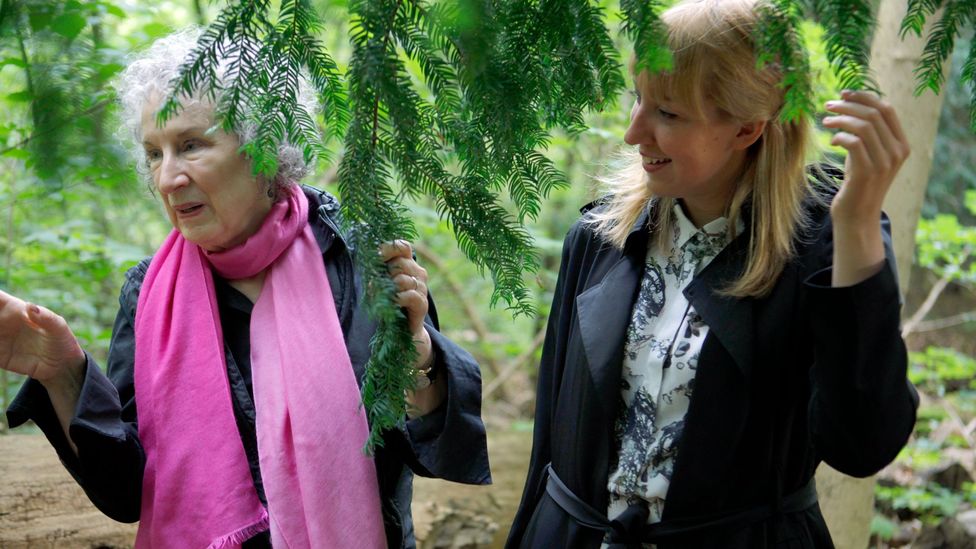
Margaret Atwood and Katie Paterson collaborated to create a story for the Future Library that volition not be read for a century (Credit: Giorgia Polizzi)
Speculative fiction is another fashion nosotros can stretch our time frames through culture. From ancient Indian vedas to the medieval Christian obsession with apocalypse, from 20 Thousand Leagues Nether the Sea to Blade Runner, we've been pondering the future for thousands of years. Dystopian visions similar The Handmaid'south Tale, The Route, or Children of Men cause us to re-examine the elements of the present that might be taking us towards nightmare scenarios.
Recently, designers and artists take sought to create visceral, immersive works that give people a more direct experience of the darker, more dystopian planet we might face if we don't start thinking longer-term. In 2017, the design studio Superflux created samples of what the polluted air of 2030 would scent like if cypher changed, and at a live result in the United Arab Emirates invited policy-makers and senior politicians to inhale them. In the words of Superflux co-founder Anab Jain, "But one whiff of the baneful polluted air from 2030 brought home the bespeak that no amount of data can."
Some other Superflux installation in Barcelona, Mitigation of Shock, transported people decades into the futurity into an apartment, set in London, that has been drastically adapted for living with the consequences of climate ending. In Jain's words: "We explored, designed and built an flat located in a hereafter no one wants, merely that may be on the horizon. Not to scare, or overwhelm, only to aid people critically reflect upon their actions in the present."
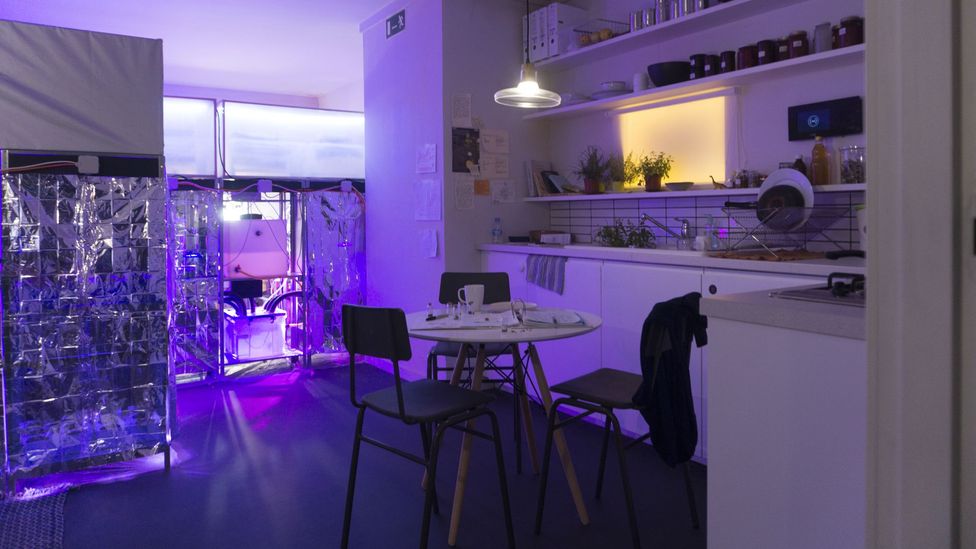
Superflux installation Mitigation of Shock allowed visitors to immerse themselves in life an apartment in a dystopian future (Credit: Superflux)
For more positive visions of the futurity, take a motion-picture show like Black Panther, which shows a thriving environmentally-friendly, technologically avant-garde African culture that has never been colonised. Edifice on the work of writers like Octavia Butler, who placed people of colour at the heart of science fiction, the film enables united states of america to explore a future that moves beyond nowadays-day prejudices. As the 2d-highest grossing pic of 2018 and the most tweeted nearly flick ever, this kind of speculative piece of work clearly has the potential to influence our commonage trajectory.
On a much more local scale, projects like Wood of the Time to come in London's Waltham Forest features speculative art and design work nearly the civic, such every bit screen-prints of future local by-laws by designer Cat Drew, to assistance decision-makers – politicians, citizens, consumers, voters, businesses – think virtually what a improve hereafter can look similar, and how to accomplish it.

Black Panther showed what a more positive future could wait similar (Credit: Alamy)
The genius of fine art and culture is that it allows us to experience ideas virtually the future on an emotional and embodied level, not just an intellectual one. Accept Olafur Eliasson's recent Water ice Watch, in which he transported melting glacial ice from the Arctic to London where the public could see and affect the blocks. "I believe that one of the major responsibilities of artists – and the idea that artists have responsibilities may come as a surprise to some – is to help people not only get to know and sympathise something with their minds but also to feel it emotionally and physically," Eliasson wrote in a 2016 article for Huffpost.
Often questions about the long-term future can experience distant and hard for people to interpret into meaningful activity in the context of their lives. It's one thing to sentinel Black Panther in the movie theatre, and another to know what its vision of the future means in the context of your own life. Art and culture can non simply help u.s. feel the long view, but tin provide reflective space to enable us to take action based on that understanding.
Somerset House's contempo Earth Day season exemplifies this arroyo with its focus on "the role of linguistic communication and storytelling inpromoting collective activity on the global climate crisis". Its mixture of immersive installations, screenings, workshops and debates enabled the public to both explore and reflect. In the words of the founder of the Climate Museum Bridget McKenzie: "We demand to move beyond seeing arts and culture in service to advice of climate action, to thinking of it equally a transformative and generative agent."
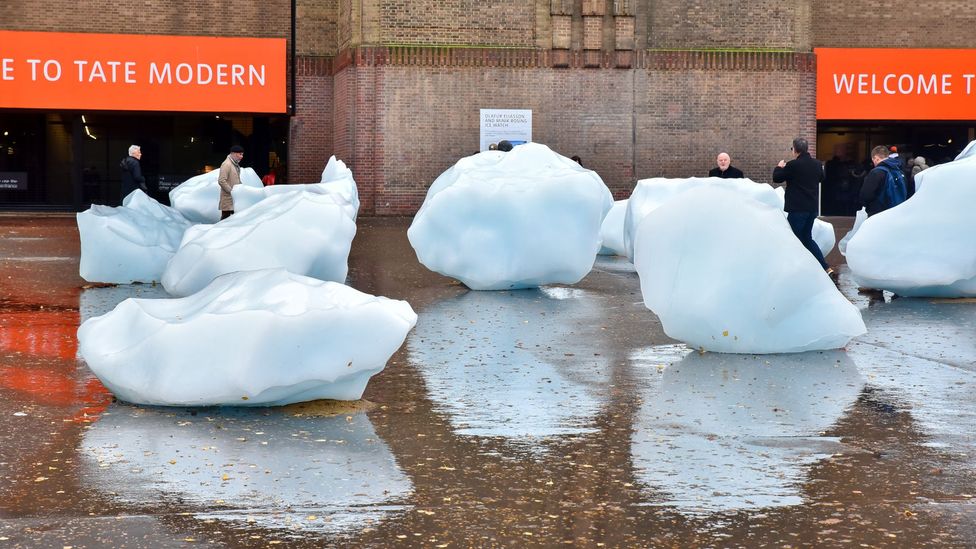
Olafur Eliasson placed melting iceberg pieces in front of the Tate Modern in London (Credit: Getty Images)
Nosotros Know Not What Nosotros May Exist was a projection at the Barbican in London adult by Zoë Svendsen of the arts organisation Metis. After a 20-minute talk from expert speakers from fields like economics, geography and ecology science, the public was invited to explore what information technology would be like to live in an alternative economic future, based on a fictional scenario devised from one of these experts' inquiry. In an immersive "factory of the future" they grappled with their part in the shape of the future through storytelling and experimentation. In the words of Svendsen, the arts "can invite the states to take on ways of operating without having to commit to them".
Or at that place's the piece of work of interactive theatre company Coney, whose 2014 piece Early Days (of a better nation) involved no actors, merely a participating audience who were told: "The state of war is over and the nation lies in ruins. You and your young man survivors must build the beginnings of a new country. What are the rules you're going to live by? And can you avoid the mistakes of the by?" The audience had to explore how they might organise themselves and run a country, testing and playing with new behaviours and scenarios.
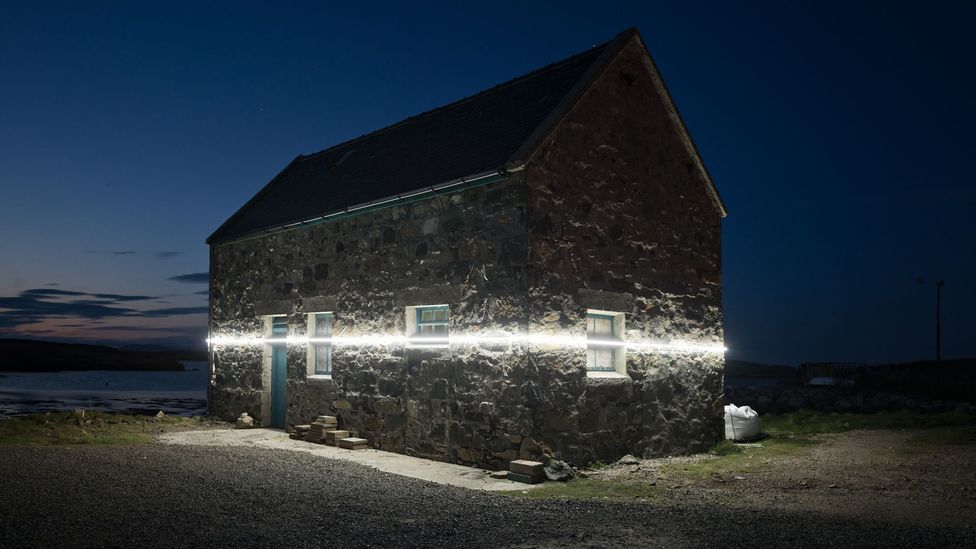
An installation past Finnish artists Pekka Niittyvirta and Timo Aho in the Outer Hebrides used light to show the impact of bounding main level rise (Credit: Pekka Niittyvirta and Timo Aho)
It's probable that acting in the interests of the long term will involve radical alter in the short term. It will involve rocking the boat, going against the norm, doing things very differently. Art and culture can assist usa do this in many ways: by connecting us with previous moments of change to make the radical feel more possible, by challenging the inevitability of the status quo, and by making radically unlike worlds feel tangible.
Art and culture can remind us that radical change has happened in the by. It tin can both inspire united states equally to the scale of previous change and it tin can remind us of the values and behaviours needed to make change happen. For example, drama that retells previous movements of change like gay rights (Milk), ceremonious rights (12 Years a Slave), or women's rights (Suffragette) tin can make us feel more courageous, willing to put more on the line and take action.
Art tin can too help usa challenge the status quo. Cultural theorist Marking Fisher wrote of fine art's office in challenging "the monopolisation of possible realities". Information technology tin can experience similar the world we live in is the only pick. Art and culture can expose united states of america to a multiplicity of possible futures.
Have Economic science Fictions, a new anthology exploring how scientific discipline fiction tin motivate new approaches to economic science, or A People'south Hereafter of the United States, with speculative stories that claiming oppression and envision new futures for the U.s.a.. Speculative work tin liberate usa from the confines of pragmatism and to dream new futures. Fictions can fuel the futurity.
Civilisation also has the power to rapidly send us out of the confines of everyday life to create embodied experiencesof different possible futures. Back in the 1960s, the Situationists, a grouping of artists in Paris, pioneered work that created moments to jolt people out of their usual ways of thinking and acting. They demonstrated that art and culture tin create spaces that temporarily append the established order, norms, and privileges. This was a facet of the contempo Extinction Rebellion climate protests in the Britain, which used art and civilization to transform the roads and bridges they occupied in primal London. The striking pink gunkhole in Oxford Circus, Samba bands, poetry, and impromptu performances from musicians all contributed to creating spaces that felt radically different from the norm.

Olafur Eliasson'southward the Weather Projection in the Tate Modern prompted meetings, celebrations, relaxation, noisy acts of protestation, and silent contemplation (Credit: Getty Images)
Ultimately, we believe that challenging short-termism will involve reauthoring some of the deeper narratives that animate our gild, the collective beliefs that shape our direction of travel – from narratives nearly our place in the natural gild of things to those which drive our economic paradigms. The stories we alive in justify the status quo, make institutions experience inevitable, legitimise certain kinds of solutions, and make our earth experience preordained. These cultural narratives are frequently foundational to the structures that incentivise short-termism, whether at the private, political, corporate or financial level. For examples of this kind of narrative shift work, encounter recent work on poverty by the Joseph Rowntree Foundation, the oceans by the Calouste Gulbenkian Foundation, and The Popular Culture Collaborative, which is underpinned by the conventionalities that "activists, artists, and philanthropists can encourage mass audiences to reckon with the by and rewrite the story of our nation's future."
Culture is foundational. Information technology is the soil from which our civilisations grow. If we want to ensure that humans have a long, thriving hereafter on this planet, then we need to piece of work at the level of civilization likewise equally politics, science, technology, finance and infrastructure. If we tin can piece of work with fine art and civilization to stretch our time frames so that we care about the long-term future, then hopefully as a species, we will have a future in the long term.
--
Ella Saltmarshe and Beatrice Pembroke are the founders of the Long Time Project , which champions art and culture as a route to helping people think and act more long-term. It is a new multidisciplinary initiative involving the creative and cultural industries, the humanities, science, media and business. Twitter: @LongTimeProject
Join more i million Future fans by liking united states of america on Facebook , or follow united states of america on Twitter or Instagram .
If y'all liked this story, sign upward for the weekly bbc.com features newsletter , called "The Essential List". A handpicked selection of stories from BBC Hereafter, Culture, Capital, and Travel, delivered to your inbox every Friday.
Source: https://www.bbc.com/future/article/20190521-how-art-and-culture-can-help-us-rethink-time
Postar um comentário for "The Context of a Work of Art Relates to Its Web of Connections to the Larger World of Human Culture"